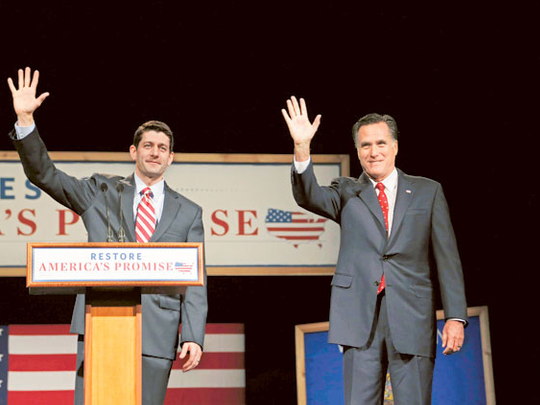
Regardless of the outcome in November, it may be possible to look back to Republican Mitt Romney’s selection of Paul Ryan as his vice-presidential running mate as the moment when the 2012 presidential election was salvaged. This race so far has been shamefully dismissive of substance — with more focus on Ann Romney’s horse and President Barack Obama’s birth certificate than jobs and scorching drought across the Midwest.
Now the contest provides a stark and perhaps conclusive choice in a debate that has gridlocked Congress at a critical moment: the role of government and how to pay for it. It’s time to have it out on this question enough to spur action in one direction or the other.
Romney’s choice is a bold move, and for that reason risky as well. As a congressman, Ryan represents one small district in Wisconsin. As House Budget Committee chairman, he is a leader in one of the most dysfunctional and least popular Congresses in history. His presence on the ticket is unlikely to shift the electoral college in any of the big battleground states where Romney has been losing ground in recent weeks.
He adds no foreign policy depth at a time when wars in Afghanistan and Syria and Iran’s nuclear ambitions will require the next administration’s immediate attention.
But for all the talk about how the bottom half of a presidential ticket doesn’t matter, the fact is it does. The choice provides a first insight into how a presidential nominee makes decisions, where his priorities lie, how he will handle competing party interests, and how he might govern. Under vice-presidents Al Gore, Dick Cheney, and Joe Biden, the office has grown in both influence and policymaking.
As a vice-presidential candidate, Biden shored up Obama’s lack of foreign policy. For Romney, who has offered a long list of ambitious policy promises without clearly explaining how he would achieve them, Ryan brings details. In an administration, Romney would have in Ryan a wonkish, genial, and energetic legislative liaison.
Well-defined proposal
Ryan’s plan is well-defined: Cut spending, reduce taxes, and rein in America’s runaway entitlement programmes. That gives Team Obama a bigger target, but it gives Romney more substance than he has provided thus far. The Ryan agenda is now the Romney agenda, and as last year’s debt-ceiling showdown revealed, the Obama administration and House Republicans face off across a wide gulf.
Prepare, then, for a battle over the middle class. To tame the national debt, the Ryan plan steps on all the third rails of American politics: privatisation of Social Security, sharp cuts and bloc-grants to the states for Medicaid (health care for the poor), vouchers for Medicare (health care for seniors), and reducing health care costs by restricting the tax code. Discretionary spending takes deep cuts, too. Without radical measures, Ryan argues, robust job creation is unattainable.
Even before Romney’s announcement, the Obama campaign was preparing to link the Republican nominee to Ryan’s plan, which it sees as lop-sided, draconian, and devastating to the middle class and the elderly.
Obama does not oppose deep cuts in government spending. The disagreement centres on how to pay for them and where to make them. In the midst of the debt-ceiling standoff last year, Obama sought a mix of program cuts and tax increases on the wealthiest citizens. House Republicans rejected that approach, preferring to shrink the debt through spending cuts and, they argue, economic growth spurred by tax cuts.
Entitlement reform
Administrations and Congresses have tip-toed around entitlement reform for years. Until now, both campaigns seemed prepared to continue that trend. Obama has attacked Romney’s business record and undisclosed tax returns. Romney has charged the president with declaring a “war on religion”.
These are not inconsequential issues, per se, but at a time of global economic uncertainty, a creaking US recovery, and a looming debt reckoning, they have distracted from the fundamental issues of deficits, jobs, and climate change — which has serious economic repercussions as well as environmental ones. The public deserves an honest, robust debate about how the next administration and Congress will address these issues.
Don’t expect Ryan’s entry in the race to end the pettiness. There’s plenty of money on both sides for attack ads and distortions. But there is also an opportunity for both sides to reach higher. There are now two clear plans reflecting two distinct views on the role of government in the economy and the range or extent of its responsibility to the general welfare.
Monthly job reports will keep the focus on the economy as November approaches. In the weeks immediately following the election, one of the two tickets will have to squarely face the pending fiscal cliff of automatic tax increases and spending cuts due in January.
At the moment, polls are trending in Obama’s favor. He’s gotten traction from negative ads, though Romney ads have also been negative. A substantive contest of ideas would have the added benefit of clarifying for voters the approach to solving the urgent issues threatening the future.
Good for Romney for staking himself irrevocably to a clearly defined policy course. Even if he loses, his choice of running mate secures a legacy of sorts. Voters have a referendum – and the Republican party has its future standard bearer.
— Christian Science Monitor
Kurt Shillinger is a former political reporter for the Christian Science Monitor. He also covered sub-Saharan Africa for the Boston Globe.









